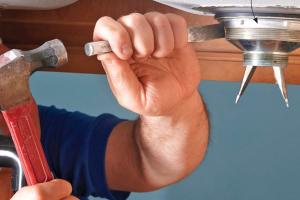Ultimate Guide: How to Remove a Kitchen Sink Drain Like a Pro

-
Quick Links:
- 1. Introduction
- 2. Tools and Materials Needed
- 3. Safety First
- 4. Step-by-Step Guide to Removing a Kitchen Sink Drain
- 5. Troubleshooting Common Issues
- 6. Real-World Case Studies
- 7. Expert Insights
- 8. FAQs
1. Introduction
Removing a kitchen sink drain is a task that many homeowners might face at some point, whether due to a clog, replacement, or routine maintenance. Although it may seem daunting, this guide will walk you through the entire process, ensuring you can handle it like a pro.
2. Tools and Materials Needed
Before starting the drain removal, gather the following tools and materials:
- Adjustable wrench
- Pliers
- Screwdriver (flat and Phillips)
- Bucket or bowl
- Plumber's putty
- New drain assembly (if replacing)
- Gloves
- Safety goggles
3. Safety First
Before you begin, ensure your safety by following these precautions:
- Turn off the water supply to avoid any leaks.
- Wear gloves and safety goggles to protect your hands and eyes.
- Keep the work area dry to prevent slips and falls.
4. Step-by-Step Guide to Removing a Kitchen Sink Drain
Step 1: Clear the Area
Remove any items from under the sink to give yourself space to work.
Step 2: Place a Bucket Under the Sink
Position the bucket or bowl directly under the sink drain to catch any water that may spill out when you remove the drain.
Step 3: Disconnect the Drain Trap
Using your adjustable wrench, loosen the slip nuts on the P-trap. Carefully remove it and let any water drain into the bucket.
Step 4: Remove the Drain Flange
From the top of the sink, unscrew the mounting hardware securing the drain flange. You may need a screwdriver for this step.
Step 5: Detach the Drain Assembly
Once the flange is free, gently pull the drain assembly from the sink. If it’s stuck, use a little force, but be careful not to damage the sink.
Step 6: Clean the Area
After removal, clean any remaining plumber's putty or debris from the sink surface.
Step 7: Install the New Drain (if applicable)
If you’re replacing the drain, apply new plumber's putty around the new drain flange and reverse the removal steps to install it.
5. Troubleshooting Common Issues
Sometimes, you might encounter issues. Here are some common problems and solutions:
- Stuck Drain: If the drain won’t budge, check for additional screws or corrosion.
- Leaking After Reinstallation: Ensure all connections are tight and properly sealed with plumber's putty.
6. Real-World Case Studies
Let’s look at a couple of real-world scenarios:
Case Study 1: The Clogged Drain
A homeowner noticed water pooling in the sink. After following the steps in this guide, they successfully removed and cleaned the drain, preventing further issues.
Case Study 2: Installing a New Sink
During a kitchen renovation, a homeowner decided to replace their old sink. Using this guide, they were able to remove the old drain and install a new one seamlessly.
7. Expert Insights
According to plumbing experts, regular maintenance of your kitchen sink, including periodic inspections of the drain, can save you from costly repairs in the future. Always use quality materials when replacing parts.
8. FAQs
What tools do I need to remove a kitchen sink drain?
You’ll need an adjustable wrench, pliers, screwdrivers, a bucket, and plumber's putty.
Is it necessary to turn off the water supply?
Yes, turning off the water supply prevents leaks and spills during the process.
Can I remove the sink drain myself?
Yes, with the right tools and guidance, it’s a DIY project suitable for most homeowners.
What if my drain is stuck?
Check for hidden screws or corrosion; using some penetrating oil can help loosen it.
How do I prevent leaks after reinstalling the drain?
Ensure all connections are secure and use plumber's putty to create a watertight seal.
Is there a specific order to follow when removing a drain?
Yes, always start by disconnecting the trap and then proceed to the drain flange.
What if I encounter a broken drain flange?
A broken flange will need to be replaced; consult a professional if you’re unsure how to proceed.
Can I use any kind of putty for the drain?
It's best to use plumber's putty specifically designed for plumbing applications.
How often should I check my kitchen sink drain?
Regular checks every six months can help prevent clogs and maintain the drain.
What should I do if I still have drainage issues after removal?
If problems persist, consider calling a professional plumber to assess the situation.
For more detailed information, you can visit the following resources:
- International Association of Certified Home Inspectors - Plumbing
- Home Depot - How to Repair a Leaky Sink Drain
- Better Homes & Gardens - Guide to Kitchen Sink Drains
Random Reads
- How to delete youtube videos
- How to delete zoosk account
- How to make your phone vibrate complete guide
- How to make your own video game
- How to delete voicemail android
- How to delete whatsapp messages
- How to transfer music to a flash drive
- How to hang heavy mirror
- How to hang pergola lights
- Invert image colors photoshop